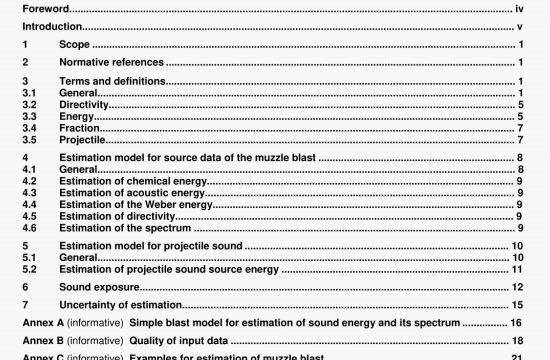BS EN ISO 17201-2 pdf download – Acoustics——Noise fromshooting ranges —— Part 2: Estimation of muzzle blast and projectile sound by calculation.
3.1.15
divergent area
S
size of the area at a certain distance from the trajectory through which the sound radiated from the respective path of the trajectory is propagating
NOTE The ergent area is expressed m square metres
3.1.16
propagation distance
distance between the source point of projectile sound, Ps, and the receiver point, P, NOTE The prcçagat.on distance a expressed in metres (m).
3.1.17
Weber radius
Rw
radius of an equivalent raating sphere of the slmpte model of expfosioW
NOTE The Weber radius is expressed in metres (mj.
3.1.18
Weber pressure
pw
sound pressure at the surface of the Weber sphere
NOTE The Weber pressure is expressed In pascals IPe)
3.2 Directivity
3.2.1
correction factor due to source directivity
Cs
correction taking into account that dill erent orders of Fourier functions contribute difterently to the energy
3.2.2
directivity factor
Y(o)
dlrectlvvty function In the direction of a
3.3 Energy
3.3.1
effective angular source energy distribution
Oy(a)
eflective energy radiated into the direction a, weighted by diroctivity
NOTE The effeciive angular source energy distnbubon is expressed in joulee steradian (JFsr).
3.3.2
total acoustic source energy
total acoustic energy after integration of Qv(u) over the whole sphere
NOTE The total acoustic energy is expressed in poules (J).
The standard-estimation is to be obtained by following the scheme (see Figure 2) along the given default parameters for all coefficients, This estimation is mandatory for the report. If a cfterent value for any coefficient is used the reason for this shall be stated.
4.2 Estimation of chemical energy
The key quantity for estimating the acoustic energy is the total chemical energy involved, Qc Ii Q is not known, two alternatives exist for determining Q. The left-hand branch uses the kinetic energy 04 the projectile. 01,0. either known directly or alternatively calculated from the mass and projectile launch speed of me prolectile Isee Equation (1), in Figure 2]. The projectile energy is a fraction of the total energy. If the fraction o is not known, 35% should be used as default. Equation (2) m Figure 2 then determines 0. The right hand branch uses the mass of propellant or explosives. The lrretus (conversion factor). u. depends on the type of propellant (e.g. 4 310 J1g for TNT, or 5 860 Jlcg for PETN). If the specific chemical energy, u. is not known a value of u • 4 500 Jkg should be used.
4.3 Estimation of acoustic energy
The energy Q, is partially converted into heat arid into the kinetic energy of the remaining gas (Op). heat arid friction between the barrel and proectile, and the kinetic energy of the projectile (Opo) or accelerated material. respectively. The inner balIstics, in case of guns, will determine this balance liii. A fraction of 45% in 0 should be used as the default value for Qg, the only source of energy in the muzzle blast. Equation (5) accounts for the efficiency of the conversion of energy , the propellant gas, O. into the total acoustic energy of the muzzle blast.
4.4 Estimation of the Weber energy
The pait on the right of Figure 2 shows the flow chart used to determine the Weber energy. Ow. which is the
energy density of a Weber source with the Weber rac5us of 1 m.
4.5 EstImation of directivity
For rotational symmetric radiation around the line of fire, the directional pattern of the source is described by a Fourier-series with respect to the angle a relative to the line of lire. If the directivity pattern, Cn, i5 not known. the matrix shown as Equation (6) in Figure 2 gives a list of default values for some weapons. Applying the directivity. Y, to O In Equation (10) En Figure 2 yIelds the energy that flows through the slice. inckidlng the directional pattern of the source.
4.6 EstImation of the spectrum
The next two steps in Equations (11) and (12) in Figure 2 use an acoustical model of explosions in air which allows an estimation of the Fourier-spectrum of the angular source energy distribution, where a is the direction as described In the Annex A, see also Reference 181- The default values are validated model parameters and should only be changed it relevant information is available. The integral in Equation (12) should be integrated numerically: there is no known analytical solution. This estimation method should not be used for the prediction of peak pressure values or similar quantities.
BS EN ISO 17201-2 pdf download – Acoustics——Noise fromshooting ranges —— Part 2: Estimation of muzzle blast and projectile sound by calculation
